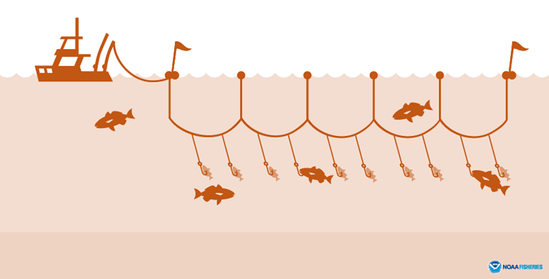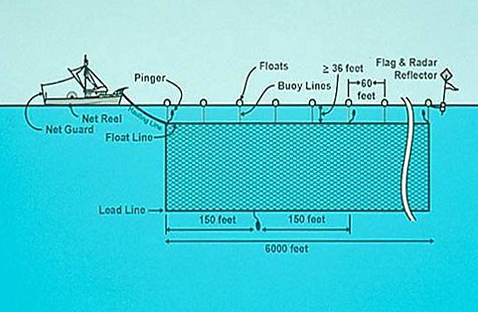The Fishery
Opah – The Fishery
How are opah caught?
Off the U.S. West Coast, opah are caught by two types of commercial fishing gear – American longlines targeting tuna, and California drift gillnets targeting swordfish. Opah are considered a secondary target because they are legally landed and sold.
Longline Fishing

Longline fishing is a common method used around the world to target tuna and swordfish. U.S. fishermen use deep-set longlines to target bigeye and yellowfin tuna off the U.S. West Coast. This gear involves one long main line affixed with many branch lines each ending with baited hooks, set deep below the surface.
Opah are caught incidentally by this fishing method, along with other species that are not retained and are collectively known as bycatch. NOAA Fisheries requires the use of various strategies to reduce bycatch, and all captains are certified on best practices to minimize bycatch and safely release the unintended catch. This fishery is extensively regulated and monitored by several management bodies, and these vessels often carry government observers onboard to quantify total catch and U.S. vessels have less bycatch than many foreign fleets.
California Drift Gillnet Fishing

The California drift gillnet fishery targets swordfish in Federal waters (i.e., beyond three miles from shore) from mid August through January. These nets of stretched mesh (>14 inches) are suspended vertically at least 36 feet below the surface with net extenders to allow non-targeted species to pass over the nets. Acoustic pingers are also attached that emit sounds to alert marine mammals away from the nets. These pingers were developed with the help of U.S. fishers and dramatically reduce marine mammal bycatch.
This fishery is highly regulated by NOAA Fisheries and operates with limited entry permits, mandatory gear requirements and time-area closures that include the Pacific Leatherback Conservation Area Closure (PLCA). The fishery currently operates in compliance with U.S. environmental regulations, including the endangered species act and the marine mammal protection act, and is considered sustainable. Click here to learn more about this fishery and the collaborative work between scientists and fishers.
Meet the Fishermen
Dave and Nick Haworth
Pete Grillo
Vessels: F/V Anthony G, F/V Heather G
Tim Jones
Vessel: F/V Gutsy Lady
Kelly Fukushima
Vessel: F/V Three Boys

